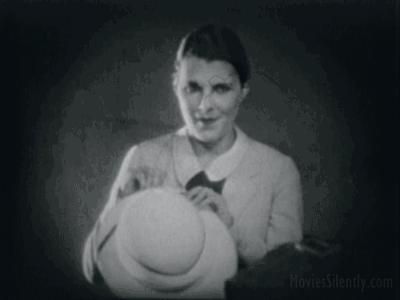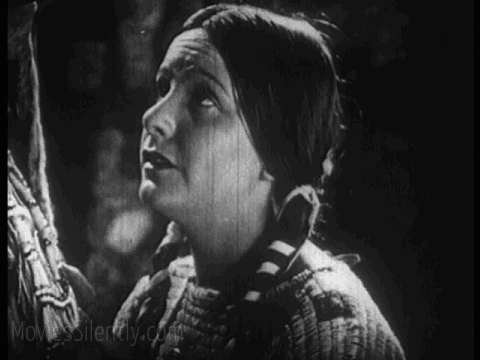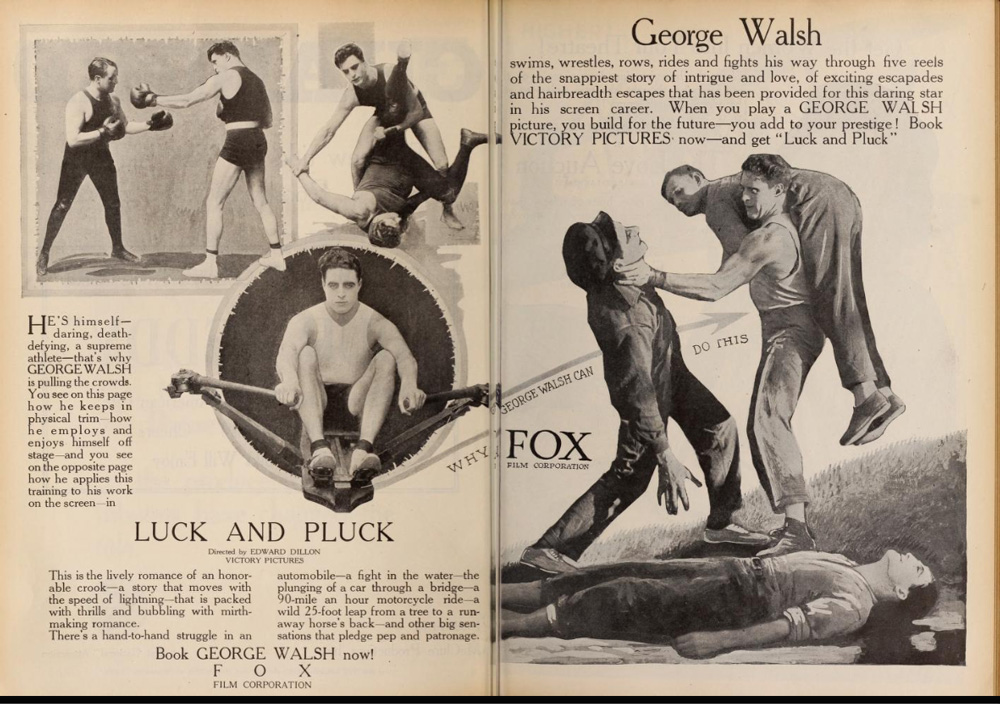We may think that snark and pointing out film errors are a modern invention but filmgoers have been heckling mistakes and cliches in motion pictures since the very beginning. Photoplay’s monthly column is a treasure trove of complaints, both major and petty.
I find this so valuable because there is a tendency to assume that audiences just accepted what was on the screen. Perish the thought! These were smart, sharp viewers who didn’t let much get past them.
My comments will be in italics.
Look Out for Crocodiles!
In the William Fox production of “The Strange Woman,” starring Gladys Brockwell, the hero is seen leaving his home, which is located in Delphi, Iowa, to seek his fortune in Paris. An exterior view of the house is shown and looming up in the front yard is a giant palm tree.
– C. P. Stutsman, Des Moines, la.
Ah, the classic problem! The mountains of California filling in for the flat midwest and palm trees everywhere. Nowadays, we look for Canadian landmarks in what are supposed to be American cities. We’ll never know for ourselves in this case as the movie is missing and presumed lost.
George Has a Big Heart
No wonder George Walsh in “I’ll Say So” didn’t make the navy. The rejection was flat feet. But what keeps me awake nights is wondering how the doctor could say that his heart was perfect by listening to his appendix. How come?
-Elmer L. Hanson, Chicago.
Mr. Hanson makes a good point but perhaps Mr. Walsh is actually a Vulcan. Hey, I take my obscure Star Trek: TOS references where I can find them. This is another lost film, by the way.

Hat Stand Needed
Although many producers do not seem to know it, guests attending functions at smart houses do not take off and put on their wraps in the drawing” room.
-C. L., New York City
In all fairness, movie people would have just been allowed into smart functions at the time. Before that, they were seen as the lowest of the low.
Long Distance Connection
In Dorothy Dalton’s “The Kaiser’s Shadow” I saw a bellboy walk the length of a room to bring a telephone to Von Kremlin, the German spy.
-Polly and Jerry, New York City.
The gag, I believe, is that a bellboy walked across the room to do anything because making cracks at minimally-paid minors is where the real humor is! I am amused by the German spy’s name. Are we sure he is working for Germany? Alas, another lost film.

Norma Heap Smart Squaw! (I am so sorry. That’s what they wrote.)
I went back and forth as to whether or not to use the original header. I ended up deciding to include it because it shows how casually these gags were thrown around, despite objections made at the time.
The introductory sub-title to “The Heart of Wetona,” featuring Norma Talmadge, explain that “Wetona was born in a tepee and educated in a fashionable seminary.” To bear out the latter idea Norma wears Fifth Avenue clothes and in accordance with the tepee stuff she speaks Indian — with an accent. For instance one caption quotes her as saying: “I doan” for “don’t” and later on she says “don’t.” Again, she says “Wetona no tell” and several captions later her English is perfect. Wetona learned quickly. But then, perhaps, they don’t teach grammar at fashionable seminaries.
-Elizabeth Breen. Chicago.
THANK YOU! I noticed this very thing in my viewing of the picture and I detest dialect title cards with the bizarre, made-up Native American “accent” being a particular pet peeve. However, sometimes when I bring these things up, I get some sniffing dope who announces that “Watching old films from a modern perspective is a no-no” or some other tripe. Well, I am watching an old film from an old perspective, per Elizabeth Breen, so neener neener. (You can read my review here.)

Rare Old Coins
Recently, upon leave, I had the pleasure of seeing Douglas Fairbanks in “Arizona,” a fine picture, but in one of the scenes, Douglas and another player match quarters to see whether or not a certain young lady is to go to a military dance.
Of course “Doug’ wins, and then follows a close up of the coin with which they match. It is one of the new issue liberty coins, and that scene was supposed to have taken place in 1898. at the outbreak of the Spanish-American war.
Private S. E. B.. Lincoln. Neb.
Nowadays, there is a dedicated company that makes prop newspapers, magazines and money to prevent exactly this sort of thing from happening. I imagine it would have been an easy mistake to make. This film is one of Doug’s lost ones.

A Considerate Bad Man
In “The Hell Cat,” Geraldine Farrar is tied hand and foot by the bad man and after her house is burned is carried away to his ranch. She is dressed for the afternoon. A few scenes later she is discovered in bed at his house dressed in a night robe which she had worn the night before her house burned.
Did the villain stop to pack a trunk for her?
-Peggie Barkley. Brooklvn. X. Y.
Mysterious costume changes are my favorite movie errors! Another lost film.
Soft for Charlie
When I saw “Shoulder Arms” of course I was glad, for Charlie’s sake, to learn that the War Department had seen fit to allow him a nice soft pillow with a white case in the trenches. Still it made me sorry for my own pillow-less soldier friends.
-Claire Strickland. Atlanta. Ga.
Whoopsy. And as near as I can recall, the pillow was a mere prop and not a gag.

To Save His Coat and Pants
Why does George Walsh always take off everything but his bvd’s when he does his acrobatic stunts?
-John Brinson. Portsmouth. Va.
Because he’s trying to be cast as Ben-Hur, whoohoo!!! BVD was an underwear brand, by the way.

people won’t know what BVDs are? have i gotten old?
I have quite a few readers outside of the United States and I always try to clarify gags and remarks based on brands and slang.
Why Do They Do It?
I am not an expert of the arctic, but neither are the creators of the Norwegian film “Laila”, starring Mona Mårtenson. How is it possible that it’s Christmas and sun is shining in a region that has about seven weeks of polar night?
I would also guess that the wolf sequencies are almost as unlikely as the Christmas sunshine. Wolves can be dangerous for reindeers, but they are afraid of people.
Thanks for the international perspective! 😀
Why do they do it?
One thing I’ve always been curious about in silent films – when a character is in a race against time through town to rescue the damsel in distress from a bad marriage, etc. (as in Harold Lloyd’s Girl Shy); wreaking havoc, who pays for the damages that were done on the way? Instead of seeking out a preacher to perform the wedding, shouldn’t he be looking for an attorney to help him with the numerous criminal damage to property charges that he’ll be facing?
Just a thought…
I was thinking that when I saw Girl Shy! And modern films that always include at least one huge landmark being destroyed… Given the reaction to Notre Dame, it seems unlikely that the public would let the destruction of, say, the Statue of Liberty go unnoticed.